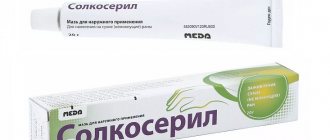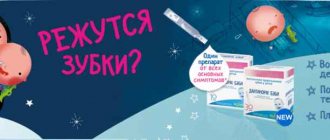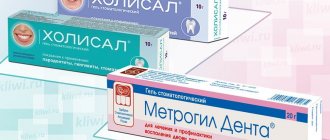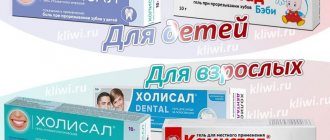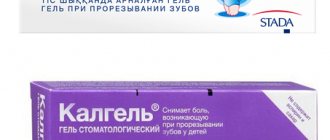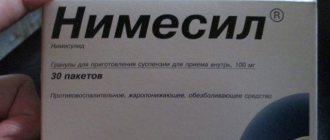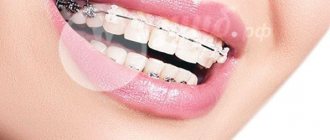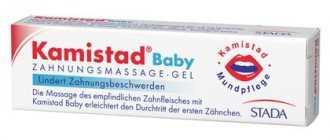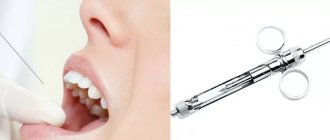Kalgel or Cholisal - which is more effective?
During teething in children, the likelihood of infection of the gum mucosa increases. To ease the pain and burning sensation, the baby begins to chew objects that he can reach. During the day, pathogenic bacteria and pathogenic fungi settle on toys or books. After their penetration into the oral cavity, there is a risk of an inflammatory process. The use of Cholisal or Kalgel will help prevent such negative developments. They are characterized by the following therapeutic properties:
- relief of inflammation and swelling of the gums;
- elimination of pain of any intensity;
- preventing the spread of infection to healthy areas of the oral cavity.
Cholisal fights inflammation much more effectively due to its active ingredients. They quickly destroy pathogenic microorganisms and disinfect mucous membranes. Kalgel relieves pain, burning, cutting and itching well. But it is used more for the prevention of bacterial and fungal infections. And to eliminate it, more powerful antimycotic and antimicrobial agents are needed.
Rules for choosing a dosage form
Kholisal is characterized by a significantly larger number of contraindications. The likelihood of developing side effects from using Kalgel is significantly lower. The dentist assesses the stage of the inflammatory process and the number of complications that have arisen. What is better for a child - Cholisal or Kalgel:
- Both gels eliminate pain within the first minutes after application to the gum mucosa;
- Kalgel is less toxic to the baby’s body;
- Cholisal has a wider spectrum of antimicrobial action;
- drugs are quickly absorbed by mucous membranes, which reduces the likelihood of ingestion;
- Cholisal better eliminates swelling, which increases pain.
When choosing a gel to relieve pain in the gums, the doctor is guided by the age of the young patient. The general state of health and the presence of diseases in the anamnesis must be taken into account.
Differences
Dental gels differ from each other not only in composition and range of applications. What else is the difference between Kalgel and Cholisal:
- Kholisal has a more multifaceted therapeutic effect;
- Kids like Kalgel more in terms of taste;
- Dental gels have different mechanisms of pharmacological action.
For a small child, Kalgel is a safer drug.
If dental gel is accidentally swallowed, digestive and peristalsis disorders occur in rare cases. Kholisal has one significant drawback. It contains anise oil, which determines the taste and smell of the drug. After applying the product to the gums, increased salivation occurs. Human saliva contains enzymes that have medicinal properties:
- bactericidal;
- antifungal;
- antiseptic.
By adding anise oil, manufacturers enhanced the therapeutic effect of the dental drug. But small children do not have time to swallow saliva, they choke and are very frightened by this condition. This can negatively affect falling asleep and disrupt feeding patterns.
How to help if you are teething?
Try this:
- Don't get angry with your baby and don't yell, even if he doesn't let you sleep for several nights.
- Rule out serious illnesses.
- Spend more time with your child: rock him, play with him, distract him with toys.
- Feed your baby on demand in a timely manner if he asks for breastfeeding or formula more often: he loses more water with saliva and diarrhea, which is detrimental to his body.
- Buy a teether, preferably filled with water. You can keep it in the refrigerator for a while, and by cooling your gums, it will reduce the discomfort in them. Instead of a teether, you can use a pacifier, which can also be slightly cooled.
- If the tooth is cutting for a long time - without fever, but with pain and itching, during which the baby gnaws on everything, go to the dentist. Sometimes the doctor only needs to make a small incision on the gum, this will be the answer to the question “when teeth are cutting, how to help.”
- You can treat your gums with a 1% soda solution (1 teaspoon per 1 liter of boiled water). It alkalizes the local pH of the tissue, which has deviated to a more acidic side due to inflammation. Consequently, inflammation, and along with it pain, will decrease. To help your child with baking soda, take sterile gauze, wrap it around your finger, dip it in the solution and treat the gums. It is not recommended to rub either inflamed or healthy areas of the oral mucosa with soda crystals.
In order to understand how to anesthetize teething teeth, you should pay attention to two approaches - systemic and local.
Taking systemic medications
These are painkillers in the form of suspensions, injections and suppositories. In medicine, they are called non-steroidal anti-inflammatory drugs, or NSAIDs for short. They work as follows: when absorbed into the blood in the intestines, they suppress the production of the enzyme cyclooxygenase in the body. Since this enzyme helps in the synthesis of substances “responsible” for pain and inflammation, its inhibition reduces the severity of the inflammatory process and pain syndrome.
Non-steroidal anti-inflammatory drugs in the form of systemic drugs act on the entire body, providing positive effects. They not only reduce pain, but also lower temperature, and, due to inhibition of inflammation, somewhat reduce intoxication. NSAIDs existing in the form of a suspension can be taken by children from 1–2 months of age.
Of course, systemic anti-inflammatory drugs “know” how to relieve pain if teething, but some of them can cause the following side effects:
- cause inflammation in the gastric mucosa, increasing the risk of formation of erosions and ulcers on it, which can bleed (acetylsalicylic acid);
- affect blood cells (acetylsalicylic acid, paracetamol, metamizole sodium);
- increase the risk of venous thromboembolism.
An overdose of, for example, acetylsalicylic acid can lead to acute renal failure with impaired function of the main working units of the kidney - its tubules. In addition, it can cause liver and brain damage - life-threatening Reye's syndrome.
Therefore, if the child is older than one year and teething occurs without fever, it is better not to resort to pain relief with systemic NSAIDs.
Description of drugs
Cholisal is a transparent jelly-like substance without a distinct taste with a faint aroma of anise. Kalgel is a colorless mass with a gel consistency, a pleasant sweet taste and herbal odor. The drugs have advantages over antiseptic solutions and ointments:
- have an analgesic effect for several hours;
- do not require frequent use;
- During treatment, the baby’s diet is not disrupted.
Applying medications to your baby's gums before bed allows him to sleep peacefully all night without feeling pain or itching. Their use also becomes an excellent prevention of stomatitis by strengthening local immunity.
pharmachologic effect
Medicines exhibit the same activity - analgesic, disinfectant, anti-inflammatory.
They have the ability to destroy bacteria, yeast-like fungi and even some viruses. The drugs effectively relieve swelling by improving microcirculation in inflamed areas. But the mechanisms of such an effect differ somewhat between gels:
- Holisal. Blocks cyclooxygenase, prevents the penetration of neutrophils and macrophages into inflammatory foci. Shows antimicrobial and antibacterial activity. Reduces the sensitivity of nerve endings, eliminating pain;
- Kalgel. Blocks sodium channels, which causes inhibition of nerve conduction. Prevents the active growth and reproduction of pathogenic microorganisms due to its antiseptic effect. Cools gums, instantly reducing pain and itching.
Dental gels improve blood circulation in tissues affected by inflammation. The supply of oxygen, nutrients and biologically active substances to the cells increases. By accelerating metabolic processes, damaged tissues heal quickly.
Composition and release form
Gels for treating gums are completely different in the composition of active and auxiliary ingredients. The active ingredients of Cholisal are choline salicylate, cetalkonium chloride, Kalgel - lidocaine hydrochloride and cetylpyridinium chloride. Dental preparations contain auxiliary components. They are necessary both to form the gel base and to ensure maximum absorption. What is the difference between Kalgel (365 rubles) and Kholisal (375 rubles) in composition:
- Cholisal: methyl parahydroxybenzoate, glycerin, hyethellose, propyl parahydroxybenzoate, ethyl alcohol, distilled water, anise oil;
- Kalgel: sorbitol, ethanol, hyaetellose, macrogol, sodium saccharinate and citrate, xylitol, glycerin, levomenthol, citric acid, caramel and herbal flavors, water.
The drugs are produced in aluminum tubes, packaged in 10.0 g units. Secondary packaging is cardboard boxes with attached instructions for use.
Instructions for use
If teething is not accompanied by inflammation of the oral mucosa, then both drugs can be used. They exhibit pronounced analgesic and distracting activity. After applying dental gels, their ingredients do not penetrate into the bloodstream. Therefore, the development of systemic side effects is completely excluded.
Kalgel - instructions for use
Indications and contraindications
The drug Kalgel is aimed at use in pediatrics, therefore it contains more flavorings and flavoring additives. Cholisal is used not only for teething. It is included in therapeutic regimens for diagnosing periodontitis, gingivitis, and stomatitis. It is used for any inflammatory diseases of the oral mucosa in adults. What is better for stomatitis - Cholisal or Kalgel:
- both drugs disinfect the mucous membranes of the oral cavity;
- Cholisal is more active against pathogenic microorganisms.
Dental gels are good at eliminating both fungal and bacterial infections. Contraindications to their use are hypersensitivity to the ingredients.
Dentists prescribe Kalgel to children from 5 months. One of the contraindications for Cholisal is age under 12 months. It is not used in the treatment of pregnant women, since its safety has not been confirmed by clinical trials. The drug is not prescribed to patients with severe heart, liver and kidney diseases, arterial hypotension.
Side effects
But doctors recommend not using Cholisal in the treatment of children under 3 years of age due to the provocation of excess salivation.
When treated with dental products, a burning and tingling sensation sometimes occurs. It disappears after 3-5 minutes. In rare cases, an allergic reaction develops - swelling and a small rash.
Directions for use and doses
The ingredients included in dental products ensure rapid absorption of active substances. The gels are securely held on the gums and do not enter the stomach when swallowing saliva. A single dose is approximately 0.5 cm of a strip of product squeezed out of the tube.
For pain relief, it is enough to apply the drug to the gums 3-4 times a day, lightly rubbing. You should first remove the resulting plaque with a sterile cloth. The duration of treatment with Cholisal and Kalgel is determined by the doctor, taking into account the speed of teething and the number of teeth.
Features of child care during treatment of stomatitis
Parents should be prepared for the fact that treating stomatitis in children is a labor-intensive process that will require a lot of attention and effort. The more accurately the doctor’s recommendations are followed, the sooner the problem will be eliminated.
Since mouth ulcers cause discomfort and pain, the baby begins to be capricious, refuses to eat, and sleeps poorly. In this case, you can use a local pain reliever, for example, Cholisal® gel. It has an analgesic and anti-inflammatory effect, and also contains an antiseptic that protects the oral cavity from pathogenic bacteria. Cholisal® begins to act within 2-3 minutes, and the effect lasts from 2 to 8 hours.
In addition to using the gel for children with stomatitis, it is necessary to follow a special diet. Food should be soft (mushy) and warm. During treatment, it is necessary to exclude spicy, sweet, sour and other foods that irritate the mucous membrane from the diet. After eating, it is recommended to rinse your mouth with solutions prescribed by your doctor in order to improve the healing of the mucous membrane and prevent the proliferation of pathogenic bacteria. To help your child sleep better, you can also use a topical numbing gel or other topical remedy for canker sores in children before bed.
Reviews
Marina, Voronezh: After a year, my daughter began to erupt several teeth at once. The doctor recommended using Kalgel or Cholisal. Just in case, I bought two drugs at once. They had the same effect - there was no difference in pain relief.
Natalya, Perm: My son’s temperature jumped several times during the day due to teething. The pediatrician prescribed Cholisal and Nurofen suspension. The medications helped a lot. I almost didn’t use Nurofen, so the dental gel worked immediately.
